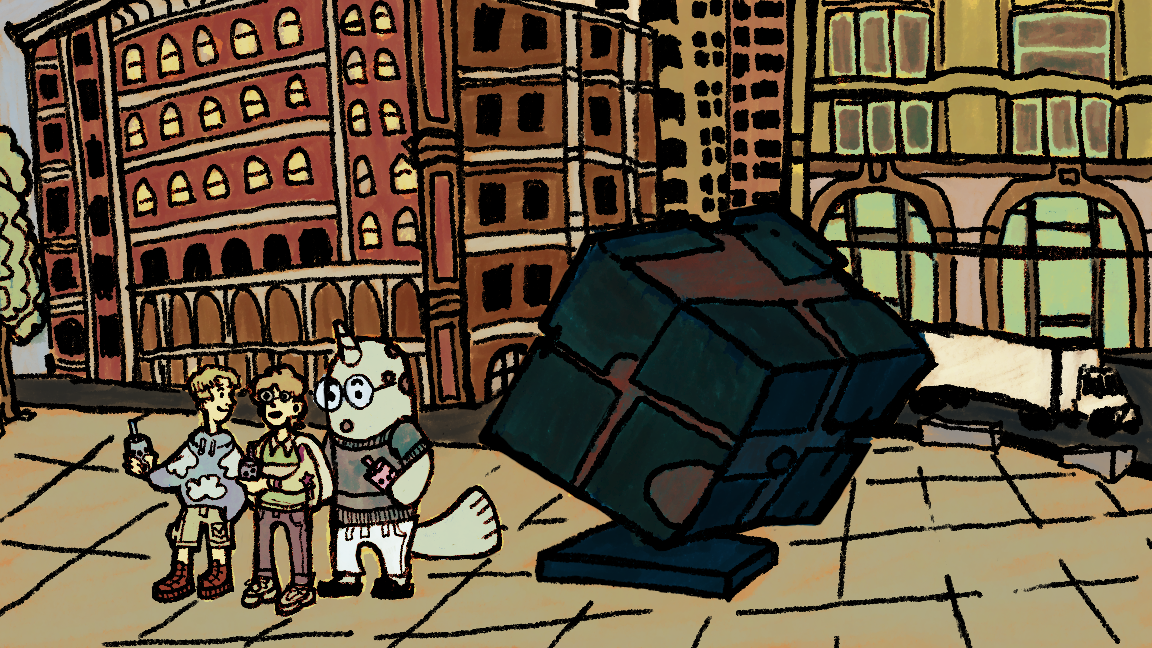The New Review is a biweekly series where writer Kayley Cassidy will examine an art installation or exhibition close to The New School campus. This week, she prioritized self-care at Astor Place while pushing Tony Rosenthal’s “Alamo.”
Astor Place is home to many college students. Whether you go to The New School, New York University, The Cooper Union, or any college in New York City, you’ve all probably ventured to the one-block street at some point for something. Whether it’s where you live, take the six train, grocery shop at Wegmans, or pass through to get that one memorable piercing on St. Marks, the plaza is a place most college students romanticized being in before coming to New York.
Fine dining, nightlife, art scenes, and historic charm all within walking distance. At Astor Place, you can feel the world at your fingertips.
Or the cube within reach.
Directly across from the Astor Place subway station, “Alamo” by Tony Rosenthal, also known as the Astor Place Cube, was installed in 1967. According to 6sqft, the cube “bears the distinction of being the first permanent contemporary outdoor sculpture installed in New York City.” Since then, the 20-foot-tall black cube balancing on one vertex has enticed the public because of a single detail. If you push it hard enough, the 1,800-pound cube, made of steel and maybe housing a man, can spin.
New Yorkers have grown accustomed to the tilted cube over the past 57 years. It stands in one of the busiest intersections and social spaces in the East Village. In such a vast concrete space, the cube looms over the public even from a distance. Whether you’re attempting to climb it with your friends at three in the morning after a long night out, pushing it with a stranger, or just walking past it, the heavy presence is always there in the background.
The way the cube tilts feels as if it’s peering down at you, just over your shoulder. It reminds us that it’s always there — watching our every move.
Let your eyes travel from the cube to the environment surrounding you at Astor Place. Listen to the sounds of skateboards rolling on pavement, inhale the smoky aroma of grilled meats from food carts, and feel the wind of college students speed-walking past you in between classes, trying to fulfill their social endeavors.
According to Rosenthal’s estate website, in a 1968 interview that detailed his observations on the cube, he said, “the fact that it moves allows people to participate. And even the fact that people climb on it; it’s all me. It all shows participation of the people in a way that it doesn’t matter whether they know about it or not; they enjoy it … Anybody can walk over and push the cube and it will turn.”
The cube makes people take notice. As an inanimate (and yet dynamic) member of the community, people detected when it couldn’t be spun for a few years and then returned to spinning in March 2023. The Department of Transportation declared the cube stopped spinning in 2021 because of structural defects from being pushed too much. Before being temporarily removed from Astor Place to repair damages, the cube was confined to a set of brackets that upset some New Yorkers, according to a report from The City.
You might attempt to push the cube and realize you cannot move it by yourself, but with the help of other hands and some pressure, it will start to move. As your hands run along the smooth, shiny, black-steel surface, you might think about similar-looking objects that have surveyed campuses, maybe your campus, across the city.
Take a seat at one of the only benches in the shape of a circle that oddly resembles the teeth of a zipper. Study the space that needs more benches and trees besides some sparse shrubs and cement. As you people-watch pedestrians navigating through this busy space, you feel warm and fuzzy, not because of the sun that’s beaming down on you in a space that lacks cover from it, but because you realize this space is nothing without the people in it. Just as much as The New School is nothing without you, your peers, faculty, and staff.
It can be overwhelming to see and experience a heavy presence like the cube. It’s ok to feel outraged by university leadership and administration because you care about students like those who walk through Astor Place. In these times of crisis, where the place you pay tuition for can seem so disappointing, I encourage you to make the time for self-care.
Self-care varies from person to person. I want you to think about how to maintain balance in your life. When stressful situations happen, we must check in with ourselves. The same questions I’ve emphasized you to ask when observing these installations, I want you to exercise with yourself.
Pay attention to how you function, your emotions, your sleep schedule, anything and everything you do.
Grab that brown sugar boba milk tea in a large at Xing Fu Tang with extra boba and less ice. Check in with your friends and support systems over a tasty but reasonably-priced pasta dinner at San Marzano. Distance yourself from campus if you need to for a little bit. Reach out to campus resources, your peers, and your professors — I am here for you too.
The cube is bound to tilt at some point given the right amount of pressure, but try not to let its presence consume you.
There have been times when the cube hasn’t spun, and as much as we may feel stuck, we cannot lose hope. We must continue to push while balancing the need to check in with ourselves.








Leave a Reply